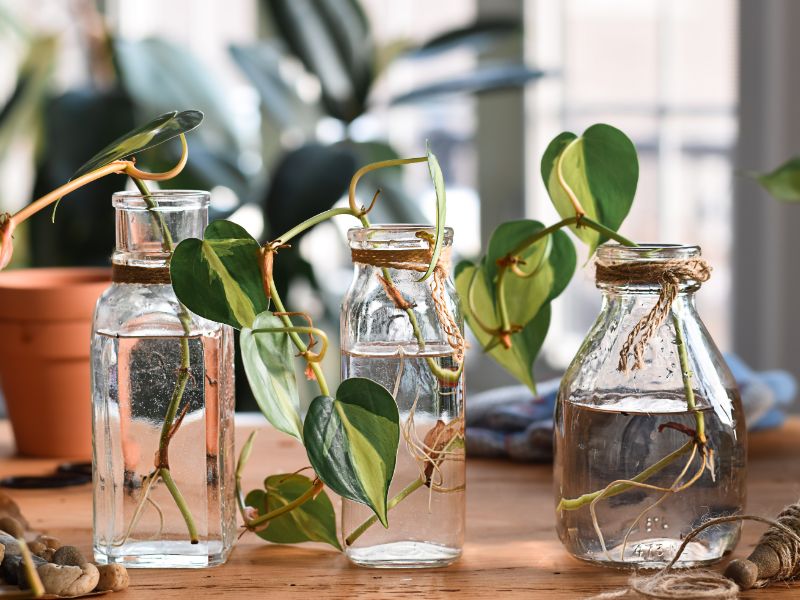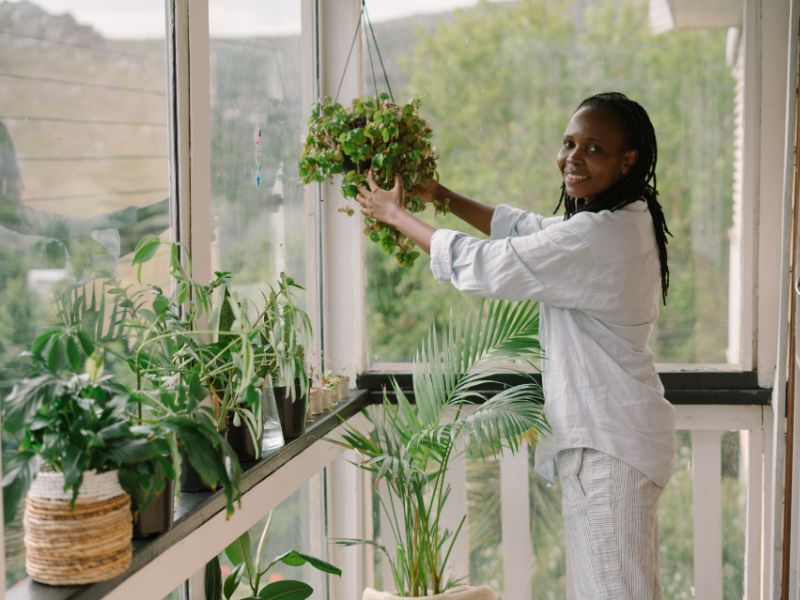We’re thrilled to guide you through the world of houseplants! If you’re a beginner, don’t worry. We’ve got you covered! We’ve compiled a list of the top 10 easy-care houseplants that’ll thrive even under the care of a novice.
They’re hardy, require minimal attention, and add a breath of fresh air to your home. So, let’s roll up our sleeves, get our hands dirty, and dive into the green world of indoor gardening!’
Understanding Houseplant Basics
Often, we don’t realize how essential it’s to understand the basic needs and requirements of houseplants for their healthy growth. We can’t merely place them in a pot and expect them to thrive. Water, light, and soil pH significantly affect their well-being. Understanding these basics can be the difference between a thriving plant and one that’s struggling.
We’ve found that overwatering is a common mistake. We must ensure the soil is dry before watering again. Regarding light, some plants require more sunshine than others, so it’s crucial to identify what each plant needs. Finally, soil pH can greatly impact a plant’s ability to absorb nutrients.
The Resilient Snake Plant
First up on our list of easy-care houseplants is the resilient snake plant, a favorite among beginners for its hardiness and low maintenance needs. Also known as Sansevieria, this plant can withstand a range of light conditions, from low light to full sun. It’s not fussy about watering either. We can let the soil dry out completely between waterings, which means it’s okay if we forget once in a while.
The snake plant also boasts air-purifying qualities, removing toxins like formaldehyde from our homes. Its stylish, vertical leaves add a touch of modern design to any room. With its ability to thrive in various conditions, the snake plant is a perfect introduction to the world of indoor gardening.

Easy-Going Pothos
Next on our list, we’ve got the easy-going Pothos, another low-maintenance houseplant perfect for beginners. It’s a resilient plant that adapts to a variety of conditions. Whether you’ve got a sunny window or a shady corner, the Pothos will thrive. It’s not fussy about water either, just let the top inch of soil dry out between waterings.
We love the Pothos for its vibrant green leaves that bring a fresh look to any room. Plus, it’s an excellent air purifier, removing toxins from your indoor environment.
As a bonus, it’s a fast grower, so you’ll see results quickly. The Pothos is truly an easy-going plant, making it a great choice for beginners.

Caring for Spider Plants
Switching gears a bit, let’s talk about spider plants, another great option for beginners due to their hardiness and minimal care requirements. These green and white striped beauties aren’t only visually appealing but also excellent at purifying the air. They’re not fussy about light so you can place them in any corner of your home. Watering them? It’s pretty simple.
We’d suggest watering them thoroughly but infrequently. Wait until the top inch of soil is dry before you water again. Be careful though, as they don’t like to be waterlogged.
Lastly, don’t worry about fertilizing often. They’re not picky eaters, so a general houseplant fertilizer every couple of months will do. With these tips, you’ll have a thriving spider plant in no time!
Peace Lily: A Beginner’s Choice
Let’s now turn our attention to the Peace Lily, a perfect choice for beginners. We’ll take you through some care tips that will help your Peace Lily thrive indoors.
Additionally, we’ll look at the wonderful benefits this easy-to-grow plant brings to your home.
Peace Lily Care Tips
We’re excited to share some simple care tips for the Peace Lily, an ideal houseplant choice for beginners. First, it’s critical to place your plant in a spot with low to moderate light, away from direct sunlight. This plant thrives in humidity, so misting it regularly or placing it near a humidifier would be beneficial.
Water the Peace Lily only when the top inch of soil is dry, but don’t let the plant wilt. Overwatering can cause root rot, which is harmful. Fertilize it lightly during the growing season, but avoid it in winter.
Finally, wipe the leaves with a damp cloth occasionally to keep them dust-free. With these tips, we’re sure you’ll enjoy the beauty of your Peace Lily for years to come.
Benefits of Peace Lily
While we’ve already covered how to care for a Peace Lily, it’s also important to understand why it’s such a great choice for beginners, mainly due to its numerous benefits. Not only are Peace Lilies relatively low-maintenance, they’re also known for their air-purifying properties.
They can effectively remove toxins from the air in your home, contributing to a healthier living environment. Aside from that, Peace Lilies also add a touch of beauty to any space with their elegant and refreshing white flowers.
They’re also adaptable, being able to thrive in both low light and bright indirect light conditions. This flexibility is why we often recommend Peace Lilies as an excellent starter plant for budding plant enthusiasts.
The Forgiving ZZ Plant
Let’s now turn our attention to the forgiving ZZ plant, another perfect choice for beginners. We’ll cover how to care for this resilient houseplant and explore its unique benefits.
This low-maintenance gem is sure to impress with its lush green foliage and ability to thrive in various light conditions.
ZZ Plant Care
Diving into the world of houseplants, we can’t overlook the ZZ plant, known for its hardiness and easy care. Requiring minimal attention, it’s perfect for beginners. We’ll now guide you through how easy it’s to care for this forgiving plant.
Place your ZZ plant in low to moderate light, but never in direct sunlight as it can scorch the leaves. Water sparingly; it’s better to underwater than overwater. We recommend letting the soil dry out between watering.
Ensure you’ve got a pot with good drainage too, as ZZ plants don’t tolerate soggy roots. A bit of houseplant fertilizer every few months will keep it happy.
There you have it! With these simple steps, we’re confident you’ll keep your ZZ plant thriving.
Benefits of ZZ Plant
Beyond its easy care, we’re thrilled to share the numerous benefits you’ll enjoy with a ZZ plant in your home. Firstly, this plant is a fantastic air purifier. It removes toxins like xylene, toluene, and benzene from your environment, contributing to healthier indoor air.
In addition, it’s a resilient beauty, tolerating low light and irregular watering – perfect for those who might forget plant care amid a busy schedule. The ZZ plant also offers visual benefits. Its glossy, deep green leaves add a vibrant touch of nature to any space.
The plant’s ability to thrive in a variety of conditions, combined with its air-purifying capabilities, make it a must-have for beginners and seasoned houseplant owners alike.
Jade Plant: Low Maintenance Beauty
In our journey of discovering easy-care houseplants, we’ve finally arrived at the Jade Plant, a low-maintenance beauty that thrives even with minimal attention.
This succulent, with its thick, shiny, dark green leaves, is more than just a pretty face. It’s extremely resilient and can survive in various lighting conditions, although it prefers indirect sunlight.
We don’t need to worry about frequent watering either. The Jade Plant is drought-tolerant and prefers to be on the dry side. Overwatering can cause root rot, so it’s best to let the soil dry out between waterings. As for fertilizing, once every six months is enough. Truly, the Jade Plant is an absolute gem for beginners in indoor gardening.
Mastering the Aloe Vera
Moving on from the resilient Jade Plant, we’re now turning our attention to yet another easy-care houseplant perfect for beginners, the Aloe Vera. This succulent isn’t only a great addition to your home decor, it’s also packed with medicinal properties.
We’re talking about an effective treatment for minor burns and cuts, right there on your windowsill! Aloe Vera thrives in well-drained soil and needs lots of sunlight. However, it’s also quite hardy and can tolerate some neglect. Just remember, too much water is its enemy.
If you’re unsure when to water, wait for the soil to dry out completely. Mastering Aloe Vera care isn’t hard. It’s all about balance, exposure to sunlight, and watering. Get it right, and you’ll have a robust, beautiful plant that can also soothe your skin troubles!
The Hardy Rubber Plant
Next on our list is the hardy Rubber Plant. We’ll start with its basic care, move on to the ideal conditions that promote its growth, and finally, we’ll tackle how to troubleshoot common problems that you might encounter. Let’s get to know this resilient houseplant better!
Rubber Plant’s Basic Care
Let’s dive into the basic care routine for the hardy Rubber Plant, a beginner-friendly houseplant known for its resilience. This tropical beauty thrives in bright, indirect light but can tolerate low light conditions. It’s not fussy! However, avoid direct sunlight as it can scorch its beautiful leaves.
When it comes to watering, we’re talking moderation. Keep the soil moist, but not waterlogged. Overwatering can lead to root rot, a common plant killer. And don’t forget, it’s a tropical plant, so it enjoys humidity. A pebble tray or occasional misting does the trick.
Lastly, it’s not a fast grower, so it doesn’t need frequent repotting. Just refresh the potting mix every spring to keep your Rubber Plant happy and healthy. That’s it! Simple, right?
Ideal Growing Conditions
In the world of houseplants, we’re hard-pressed to find a more resilient species than the Rubber Plant, especially when provided with the right growing conditions. Ideally, they thrive in bright, indirect light. Direct sunlight can scorch their leaves, so we recommend placing them near a window that gets filtered light.
Temperature-wise, they’re comfortable in typical indoor conditions – between 60 and 75 degrees Fahrenheit. Humidity is also important, as they originate from tropical climates.
Misting their leaves or placing a tray of water near them can help maintain the moisture they crave. Finally, they prefer well-draining soil; a mix of peat, pine bark and coarse sand works well.
Follow these guidelines, and you’ll have a healthy, hardy Rubber Plant.
Troubleshooting Common Problems
Addressing common problems with the Rubber Plant, we’re here to guide you through some potential issues you might encounter.
First, if you notice yellowing leaves, it’s often a sign of overwatering. Cut back on your watering schedule and ensure your plant has adequate drainage.
Next, drooping or wilting leaves can indicate low light or temperature changes. Move your plant to a brighter location and keep it away from drafts.
Lastly, brown leaf tips may reflect low humidity. Try misting your plant or placing it on a tray with pebbles and water.
Succulents: Your First Plant Friend
Often, we recommend succulents as the perfect beginner’s houseplant due to their low-maintenance nature and diverse aesthetics. These little gems don’t need constant watering or direct sunlight, making them ideal for those of us who are a bit forgetful or live in less sunny climates.
They’re resilient, too – even if we neglect them a bit, they’ll usually bounce back with some care. With countless species, they come in a variety of shapes, sizes, and colors, letting us mix and match to suit our style.
So, if you’re new to the houseplant game, why not start with succulents? They’re forgiving, aesthetically pleasing, and a great introduction to plant parenthood.
These are our top 10 easy-care houseplants for beginners
From the resilient Snake Plant to the easy-going Pothos, there’s a plant out there for everyone. Whether you’re a seasoned green thumb or just starting out, these plants won’t let you down.
Remember, caring for plants can be a breeze with the right knowledge. So, go on, bring some green into your home and start your plant parenthood journey today!






